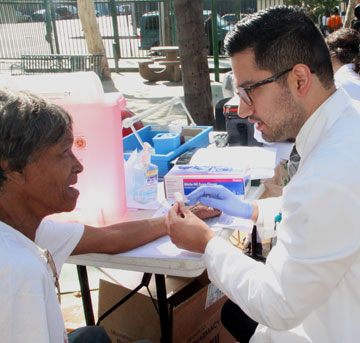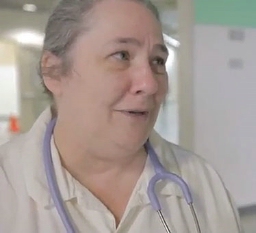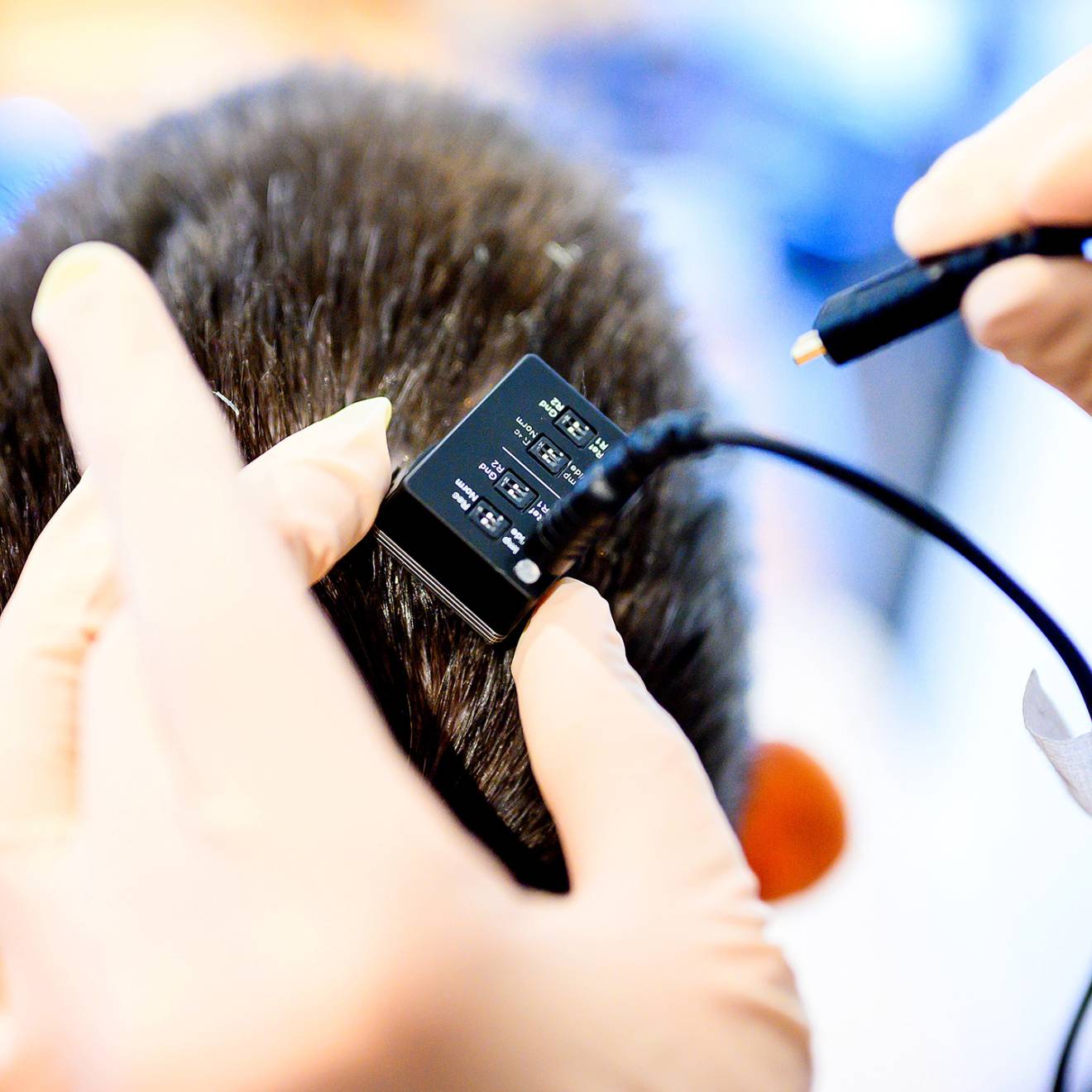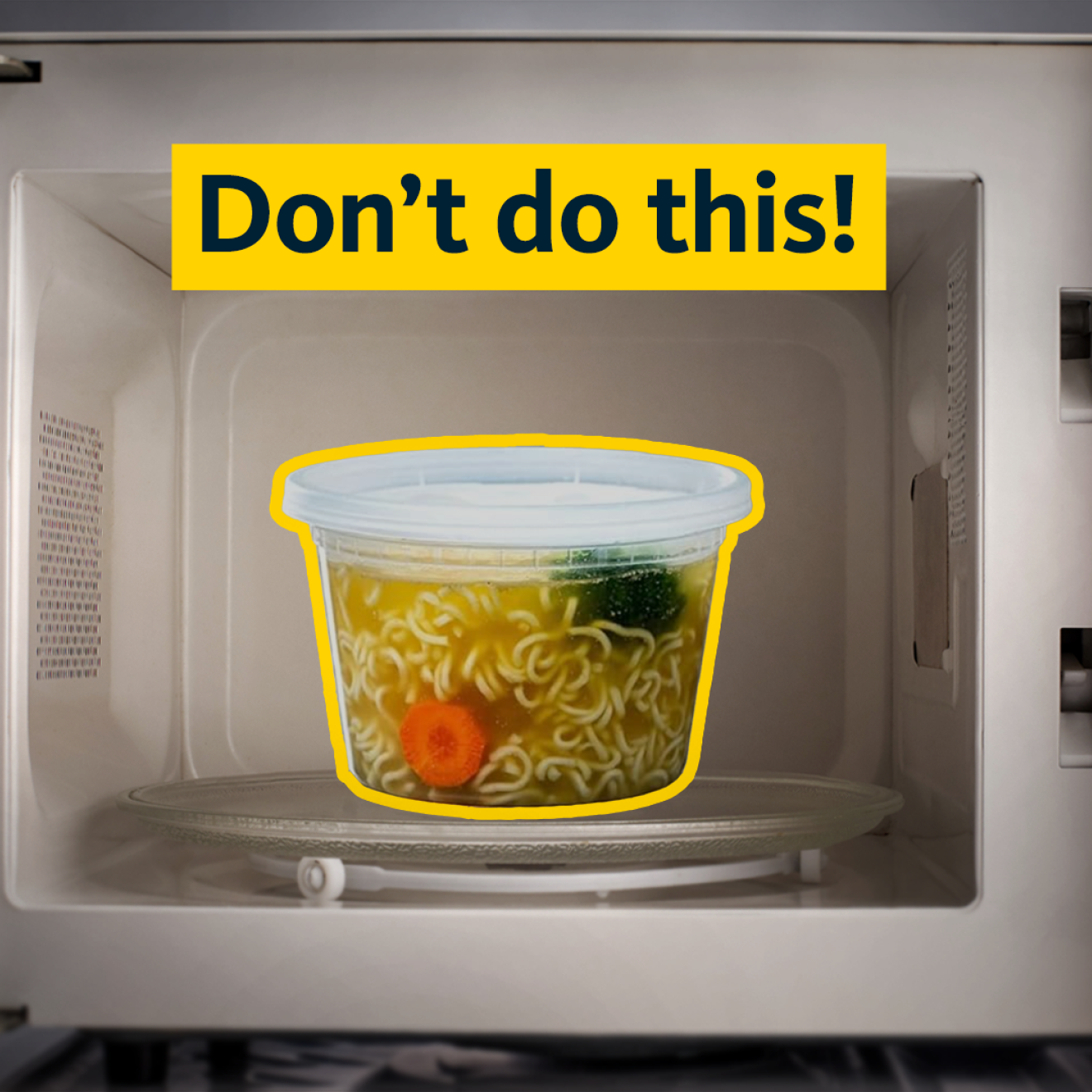Cynthia Lee, UCLA Today
Each morning as the gate to fenced-in Gladys Park is unlocked, homeless men and women move in from wherever they have spent the night on downtown L.A.’s skid row.
One group gathers near the portable bathroom stalls in the park; others take over a picnic shelter for their daily domino game. A few claim park benches to watch the activity — legal or otherwise — on Gladys Avenue.
As a new day breaks on this shabby block of walk-up apartments, boarded-up storefronts, a drop-in rehab center and soup kitchen, a small group of strangers appears in the park carrying a folding table, a few metal chairs and boxes of health forms, needles, medicine vials, syringes and alcohol swabs.
This team of three medical, nurse practitioner and doctoral students has been dispatched by the UCLA School of Nursing Health Center, located on skid row, to do tuberculosis testing where the down-and-out gather and to take a stand against a serious TB outbreak that has public health officials worried.

Since January, when county health officials issued a health alert about the outbreak, the Los Angeles County Department of Public Health and the Centers for Disease Control and Prevention have been working to control the situation with the help of three public health facilities on skid row, including the UCLA nursing clinic inside the Union Rescue Mission. Public health officials have identified 78 TB cases that have occurred on skid row in 2007-2012. Of those cases, 60 people were homeless. And of those 60, 11 died of TB. All of these cases could have been treated with medication, the county reported.
Genetic testing showed that the cases were all linked to a particular strain. “They all had the same genotype,” explained Dr. Mary Marfisee, medical director of the nursing clinic and its only staff physician. “That’s significant in that it’s likely that people got it from each other.”
So the clinic has marshaled its staff, medical and nurse practitioner students from UCLA, volunteers and others to expand TB screening at the mission and to start outreach testing in other places where the homeless gather. “Our screening has gone up about 200 percent,” said Dr. Marfisee at the clinic, where patient load has ballooned from 8,000 to 11,000 annually over the last two years.
"Clinics like Dr. Marfisee's, based in the community and known and trusted by this population, are essential partners in this effort to bring this outbreak under control," said Dr. Robert Kim-Farley, director of communicable disease control and prevention for the county health department. "The program is just starting so we won't know the full impact of increased screening for some time." But in instances where similar efforts have been made elsewhere, TB cases have been reduced, he noted.

TB has always been a concern at the mission, where the clinic does TB screening biweekly and it’s a requirement for anyone who seeks shelter there. “We were always good at it,” said Marfisee as 18 men waited to be tested in the mission’s cavernous dayroom. “We’ve really stepped it up. So anybody we don’t know or don’t recognize as having been screened, we go right up to them and say, ‘How about a TB test?’“ Employees, guests, volunteers, visitors — no one is overlooked.
Helping the clinic increase its vigilance are medical students in a program jointly run by the UCLA Geffen School of Medicine and Drew University that specifically trains physicians to serve the homeless, poor and others in underserved communities. “It really does take a village when it comes to health care for the homeless, and that’s an understatement,” the physician said.
The fact that TB is spreading on skid row comes as no surprise to Marfisee. “Since 2006, there’s been at least seven or eight cases right here in this building,” the physician said. “We were very glad that the public health department and the CDC decided to acknowledge this is going on.”
The homeless are more at risk for TB than other populations because they often live in crowded conditions. This includes those living in shelters as well as those out on the streets where sidewalks are packed tight nightly. Marfisee noted that staying in a shelter doesn’t pose a higher risk than staying out on the street. The homeless are also vulnerable because their immune systems are weakened by poor nutrition, illness and stressful living situations.
Their dire economic straits don’t preclude their being concerned about their health, said Antonio Vera, a medical assistant who manages TB testing at the Union Rescue Mission. “People [on skid row] are aware of what’s happening, and they are concerned,” said Vera, who once was homeless and a patient at the clinic before Marfisee encouraged him to go to school to train for his current job. For one thing, said Vera, now a UCLA employee, “you have to be healthy to survive down here.”
Shelter resident Everett Gainer said the terror of TB is always present in the shelters where he has stayed. “I hear people coughing all night. Why don’t they separate them from us? … Those people are going to spread it to us, and then we’re going to give it to other people. It won’t stop. It’ll just keep on going." He added, “I don’t want to die from no TB.”
Back at Gladys Park, more than a dozen people straggled over for a shot given by UCLA-Drew University medical student Miguel Garcia, who graduated from UCLA’s medical school last week, and Caroline Dos Santos, an R.N. enrolled in UCLA’s nurse practitioner program. Y. Sherieda Stewart, a nurse practitioner from another downtown clinic who is studying for her doctorate and being supervised by Marfisee, runs the TB outreach events for the clinic.
Educating the homeless about the signs and symptoms of TB and how it spreads is a vital part of what the team does. Jamie Lynn, 33 years old and pregnant, wandered over for a test. “It won’t hurt my baby, will it?” she asked, turning her head to avoid looking at the needle. “I just want to have a healthy baby. I don’t want to have any germs or be around any disease … What is TB? Tuberculosis, isn’t it? I really don’t know much about it.”
Sharon Beal, 68, got tested because she’s been in a hospital before and isn’t eager to return. “If I do have TB, where do I go? What do I do?” A positive TB screen doesn’t necessarily mean active TB, so those who test positive are sent for X-rays. For those diagnosed with active TB, a daily or biweekly regimen of pills may be called for.
But getting people to be tested is the first step — not an easy one as Dos Santos and Stewart discovered as they tried to coax people to spare a few minutes to get tested and then to return in two days to have the results read.
“Can you give me about 30 minutes? Because I’m getting high right now,” one man told Stewart as she tried to nudge him across the street to the park.
Frustration comes with the territory, the nurse practitioner said. She’s been trying for weeks to get an organization nearby that attracts large numbers of transients to allow her to set up testing there, but no one has been willing to grant her request so far.
“I’ve learned whose toes not to step on,” Stewart said. “I’m careful not to push too hard because this is their territory. I just want to provide these important preventive services and educate people about TB. So I try not to get upset.”
If coaxing doesn’t pull people in for a test, Stewart’s trump card is a $5 Subway gift card, but given only after they return for follow-up two days later. She pays for the cards out of her own pocket. “Sometimes people will only do this if there’s an incentive. But I feel this is important enough for us to give you something to do it.”
Watching from the sidelines was Kevin Michael Key, a community organizer for a local substance abuse treatment center who, Stewart said, has been a valuable neighborhood contact for them.
Key said there are two schools of opinion among the homeless about the outbreak. “Some people are worried about what’s happening down here. They want to get tested,” he said. “But there are many in this community who think it’s a ploy led by the police, thinking that if they can scare you, they can get rid of you … People are extremely suspicious that this thing has to do with more than their health.”
That skepticism doesn’t weaken Dr. Marfisee’s resolve to tamp down on TB. “They can think that if they want — and sometimes those are understandable suspicions. But we just have to work as hard as we can to make them realize we are here to keep them healthy.”
The Rev. Andy Bales, CEO of the Union Rescue Mission, doesn’t need any convincing that the TB threat is serious. “I’m trying to keep everybody from panicking. But it is a truly difficult disease to treat, especially if it’s concentrated in an area like skid row,” said Bales, who runs the 122-year-old mission.
Of the increased efforts being made by the nursing clinic and its dedicated staff, students and volunteers, Bales said, “We just really appreciate these services. UCLA is really a lifesaver at the Union Rescue Mission.”

